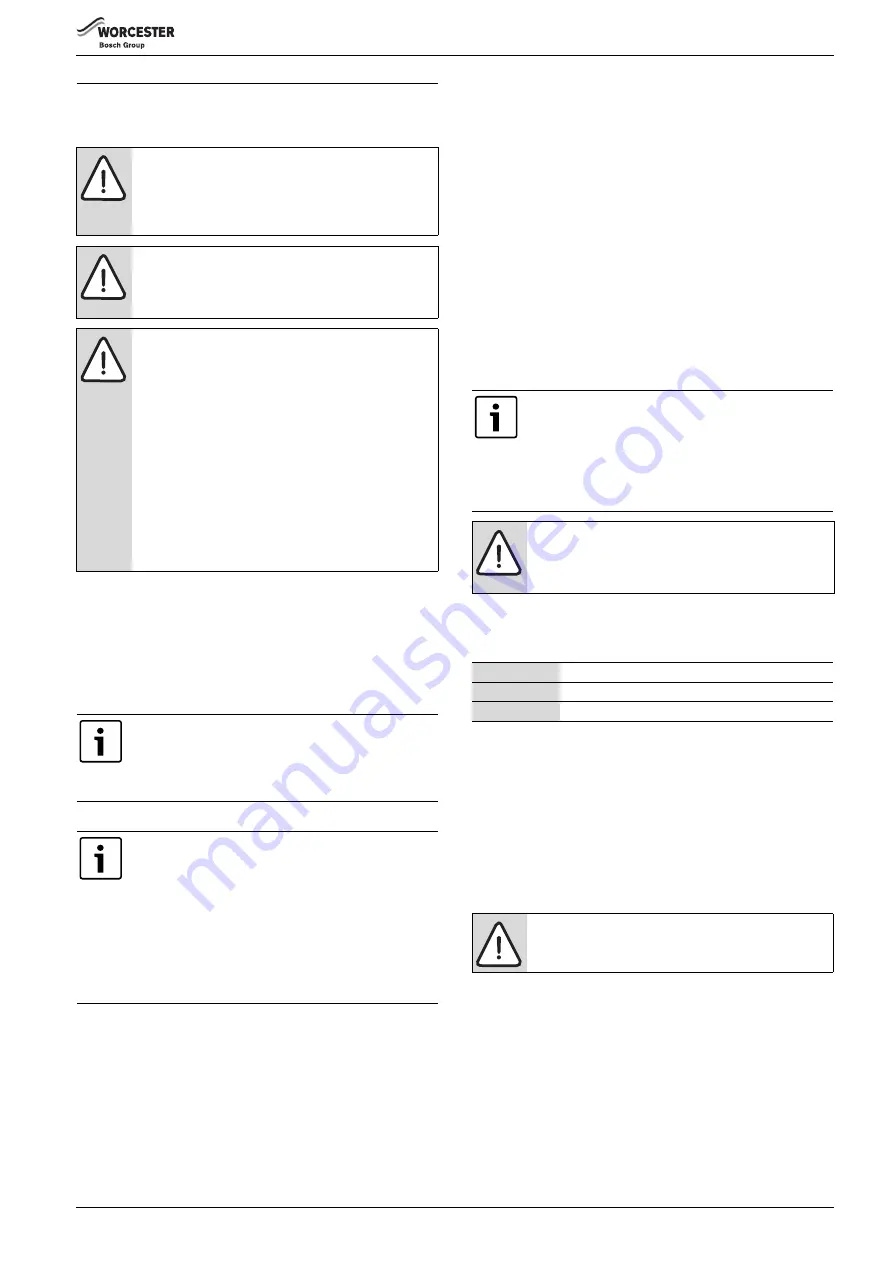
Pre-Installation
Greenstar Utility
ErP -
6 720 821 751 (2018/04)
9
4
Pre-Installation
4.1
Cleaning primary systems
4.1.1
Before cleaning the system:
▶ Ensure that the system and pipe work is in good working order.
▶
Where possible keep the existing appliance/circulating pump in
place when flushing the system.
Follow the guidance of BS7593:
Treatment of water in domestic hot water central heating and also the
flushing guidelines below.
4.1.2
Flushing the system
Flushing the system once the appliance has been fitted
The system may require flushing at some later date
▶ Fill the system with cold water and check for leaks.
▶ Turn off the water to the system header tank.
▶ Open all drain cocks and drain the system.
▶ Close drain cocks and add a suitable flushing agent at the correct
strength for the system conditions in accordance with the
manufacturer's instructions.
▶ Mark the position of the lock shield valves and then open them fully.
▶ Fully open all TRVs
▶ Circulate the flushing agent before the appliance is fired up.
▶ Run the appliance/system at normal operating temperature as
directed by the manufacturer of the flushing agent.
▶ Drain and thoroughly flush the system with clean water to remove the
flushing agent and debris.
▶ A power flushing machine may be required under some
circumstances to aid the cleansing process.
▶ Close the drain cocks and manual air vents.
▶ Close all lock shield valves to their original positions and close down
all TRVs to the required settings
▶ Add a suitable inhibitor to the system in accordance with the
manufacturer's instructions and fill the system.
4.1.3
Inhibitor
Add a suitable inhibitor or combined inhibitor/anti-freeze, if the system
is exposed to freezing conditions, to the heating system in accordance
with the DWTA code of practice and manufacturer‘s guidelines.
Water treatment products
Suitable water treatment products can be obtain from the following
manufacturers:
4.1.4
Artificially softened water
It is possible to have an ion exchange water softener fitted to the cold
water system of the property. However, the appliance requires an
untreated cold water connection taken from the mains supply, before
the water softener, to the primary water filling point of the heating
system.
Alternatively there are water softening/treatment devices that do not
adjust or alter the pH levels of the water. With these devices it may not
be necessary to provide an untreated water by-pass to the primary water
filling point of the heat system.
DANGER:
Danger to life through electric shock!
▶ Before carrying out any work on electrical
components, isolate them from the power supply
(230 V AC) (fuse, circuit breaker) and secure against
unintentional re-connection.
NOTICE:
Risk of damage to appliance or accessories!
▶ All the following pre-installation sections must be
read and requirements met before starting the
appliance or flue installations.
NOTICE:
Risk of damage to system or appliance!
Debris from the system can damage the appliance and
reduce efficiency. Failure to comply with the guidelines
for the use of water treatment with the appliance will
invalidate the appliance guarantee and contravene the
Building Regulations.
▶ It is a requirement of the Building Services
Compliance Guide which is a second tier document
to the Building Regulations to flush and inhibit the
primary water system in accordance with BS 7593.
▶ It is recommended that you fit a primary water
cleanser to the system. Worcester recommends
fitting a filter that will help remove both magnetite
and non-magnetic debris.
Worcester, Bosch does not recommend flushing the
existing central heating system with the new appliance
fitted. Always employ an after-market power flushing
system or similar to remove magnetite and other debris
from the central heating system.
Best practice is to follow the guidance given in BS7593:
"Code of practice for treatment of water in domestic hot
water central heating systems".
BS7953 recommends flushing the system before the
new appliance is fitted to a new or an existing central
heating system and adding chemicals to clean and inhibit
contamination by following the manufacturer's
instructions. Even new central heating systems contain
contaminants that need to be removed before treating
the system with inhibitor/anti-freeze.
The inhibitor or combined inhibitor/anti-freeze must not
cause damage to the materials within the appliance (mild
steel, stainless steel, copper and brass) and any other
materials/components within the system.
▶ The concentration level of inhibitor in the system
should be checked every 12 months or sooner if
system content is lost.
WARNING:
Sealing agents
▶ In cases where all attempts to find a system micro
leak have failed, Worcester, Bosch Group supports
the use of Fernox F4 leak sealer.
ADEY
01242546717 - www.adey.com
FERNOX
0870 601 5000 - www.fernox.com
SENTINEL
0800 389 4670 - www.sentinel-solutions.net
NOTICE:
▶ Salt based, softened water must not be used to fill
the central heating system.










































